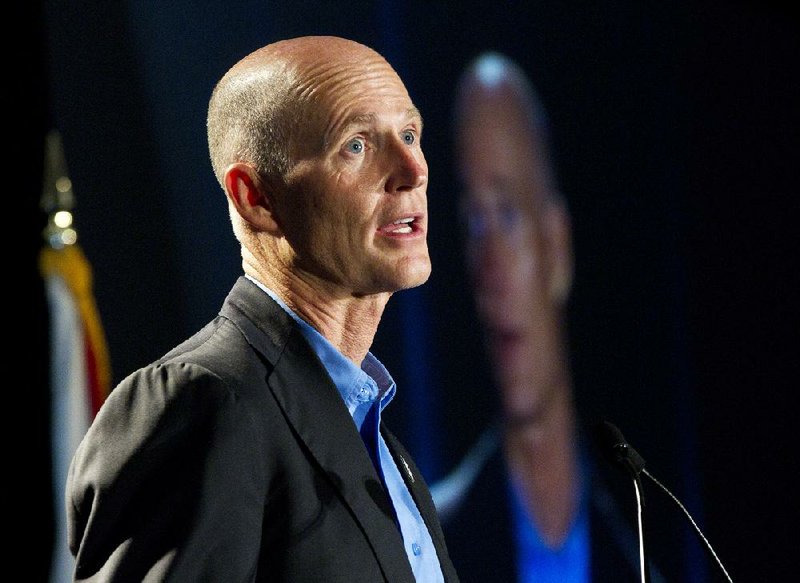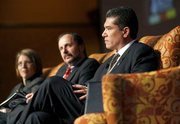NAPLES, Fla. -- For a long stretch, government spending cutbacks at all levels were a substantial drag on economic growth. Now, finally, relief is in sight.
For the first time since 2011, local, state and federal governments are providing a small but significant increase to prosperity.
"There's not a lot of positive contribution coming from the government sector, but when you're talking about economic growth, less of a negative is a positive," said Chris Varvares, senior managing director and co-founder of Macroeconomic Advisers, an economic consulting firm.
And so on a recent windswept afternoon, John Lynch, armed with a police radio and a giant net, stood along a fishing pier in Naples, Fla., on guard for pelicans that might become entangled in fishing lines.
"That's my job, to try and get them to safety," said Lynch, a retired banker.
Lynch is one of the latest additions to the city's payroll. His is the kind of government job this Gulf Coast town never would have even contemplated during the recession.
"When everybody else is cutting back, you don't hire people," said Ann Marie Ricardi, the finance director in Naples, about 130 miles south of Tampa.
Across the nation, state and local governments, Democratic and Republican alike, are spending on projects that were stalled. Teachers, who were laid off in droves in recent years, are being hired again. Even federal spending in some sectors is on the rise.
But no one is making plans for spending sprees, said Donald Boyd, senior fellow at the Nelson A. Rockefeller Institute of Government. Many officials were spooked by the most serious economic downturn since the 1930s, he said, and these are still tough times for many states and localities.
"It's just in comparison to what they were, they're great," Boyd said.
Since the stimulus programs approved in 2008 and 2009, Republicans in Washington have pushed to cut federal spending; even the $1.1 trillion budget bill that Congress recently passed to keep the government operating through September abides by spending caps and includes further trims.
But there is less of a political drive to slash spending as the federal deficit has declined sharply, said Ron Haskins, a senior fellow at the Brookings Institution in Washington.
The Congressional Budget Office now projects an annual deficit of 3 percent of total economic activity or less through the end of the decade, well under its post-World War II average. And with interest rates at rock bottom, the Treasury's cost of borrowing is barely 1.3 percent of gross national product, an unusually low level that imposes little burden on taxpayers.
"This new revenue, the increase in the economy, the increase in GDP -- everything is looking good," Haskins said. "It's releasing pressure to be fiscally restrained."
Federal spending for repair and construction of roads, schools and hospitals is increasing. Medicare and Social Security spending is rising, too, though at a comparatively modest rate, mostly because the previously relentless rise in overall health care spending has markedly slowed.
Looking ahead, some economists are counting on spending on infrastructure and other capital investments to help nudge the economy ahead.
"That's where the real momentum will be, longer term," said Diane Swonk, chief economist at Mesirow Financial in Chicago.
On the state level, signs of budget gaps and midyear budget cuts that were typical during the recession have diminished. Still, state revenue is creeping up, not booming, which translates to only incremental improvement.
More people are working in schools now than a year ago, for example, but there are still nearly 300,000 fewer than before the recession, said Michael Heenan, a spokesman for the American Federation of Teachers.
A recent report from the National Association of State Budget Officers found that general fund expenditures in state budgets enacted for 2015 increased collectively 3.1 percent from the same time frame a year ago. But that is less than the typical increases in the years leading up to the recession.
"There has been some belt-tightening that looks like it's not going to be loosened again," said Tara Sinclair, an associate economics professor at George Washington University and economist for the online job site Indeed. "People may be breathing a little easier. But there's not tons of money sloshing around even for minor expenses."
The recovery has been uneven for governments across the country. Some states are being left behind altogether. Alaska, for one, has been stung by the plummeting cost of oil after projecting that it would be much higher. Other oil-rich states, such as Texas, Oklahoma and North Dakota, are bracing for cutbacks.
By contrast, California has wound up with more revenue than expected, a turnaround from a few years ago, prompting talk of more financing for education, including community colleges.
Yet even in California, the celebrations of the end of hard times are restrained.
"I caution that we've been through a difficult downturn here," said Michael Coleman, fiscal policy adviser to the League of California Cities. "Reserves have been spent down, so we're skating on thin ice."
Florida Gov. Rick Scott signed a $77 billion budget this summer that offers tax cuts while providing more money for education, museums, sewer projects and a bicycle trail.
In a statement after signing the budget, Scott referred to the economic wringer the state went through after the housing bubble burst and Florida's unemployment rate rose to more than 11 percent. The governor argued that the new budget "will keep the great Florida turnaround story going."
For the city of Naples, it was clear the squeeze was over: For the first time since the recession, it had a budget surplus.
That was one reason the city finally agreed to conservationists' request that it dedicate $10,000 for two part-time workers to help trapped pelicans -- birds whose constant presence hovering over the shore makes them practically town mascots. At least three times in the past year, concerned residents called firefighters to rescue some of the birds who were dangling from the bushy branches of Australian pines or tangled in fishing line discarded at the pier.
The Naples Pier outreach assistant job was a minor item in the $32.9 million budget but an important symbol that times were flush again.
During the hard years, Naples, with a population of 20,000 year-round residents and an extra 15,000 during the balmy winter season, used its stash of reserves to balance its budget. A wealthy town with a tax base of beachside mansions and tourist dollars, Naples was cushioned from the body blows the recession dealt nearby communities such as Cape Coral and other cities plagued with foreclosures.
But even in Naples, the recession stung. Commercial development in the town halted. Property values dropped as much as 18.5 percent.
Naples canceled its annual Easter egg hunt and haunted house. The city laid off maintenance workers and let job openings go unfilled, shaving 60 spots from the city payroll of about 500.
Now, a 220-unit condominium complex is underway at the site of a former newspaper building. Single-family homes expected to cost as much as $2 million each are being built alongside the Gordon River. And the city is pitching in about $5 million for a new mangrove-lined park, but spending will continue to be tight, said Ricardi, the budget director.
"Nobody wants to forget where we were and what happened," she said.
Still, there is more breathing room. The Naples Fire-Rescue Department just bought two new emergency vehicles worth $196,000 each. One of the boxy red trucks arrived last month, just in time to be steered gingerly down the route of the city's annual Christmas parade, where palm trees were adorned in white holiday lights and children darted for candy tossed from holiday-themed floats.
It is an event so precious to locals that the city kept it going during the downturn, said Mayor John Sorey.
"We've got to preserve the wow factor," he said, "or all our tourists could go somewhere else."
A Section on 01/02/2015


